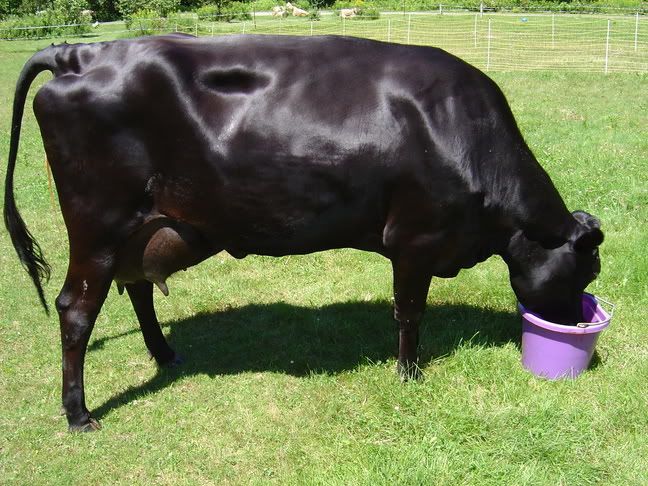Post by Joann on Sept 18, 2005 10:40:26 GMT -5
Cow Grazing Genetics
Heather, I know you have thought and read quite a bit about cows’response to grazing.
I notice on another forum that it is believed by some that the older Jersey genetics enable better feed response to grazing compared to other blood lines. While the desire to achieve good feed conversion and production on grass/hay alone undoubtedly was of interest in former centuries, it has not been a major goal during the last 50 years of dairy breeding. It is quite a new enthusiasm today among people interested in family cows.
Some sheep breeds have for centuries been selected for thriftiness on rough grazing so it would seem to be an attainable goal given time and interest. At the present time, what I am seeing appears to include a great deal of anecdotal evidence as to the superior thriftiness of some Jerseys over others. A great deal is known about the adaptation of the rumen in cattle raised on pasture as compared to cattle raised in confined feeding. The rumen of cattle accustomed to confined feeding develops differently and such cows are unthrifty if moved to a grazing situation. If we were to extrapolate from what is known of nutrition in other species from rodents to humans, it can take three generations to recover from DNA changes brought about by deficiencies. These are not permanent genetic changes; they are corrected by a couple of generations of improved diet.
It would seem to me that before paying a premium for blood lines reputed to embody the twin goals of thriftiness on pasture alone and maintenance of low production, one would need to know to what degree we might just be purchasing stock with a rumen adapted to grazing because of a life on grass.
Would you, or anyone, care to comment on this topic?
Heather, I know you have thought and read quite a bit about cows’response to grazing.
I notice on another forum that it is believed by some that the older Jersey genetics enable better feed response to grazing compared to other blood lines. While the desire to achieve good feed conversion and production on grass/hay alone undoubtedly was of interest in former centuries, it has not been a major goal during the last 50 years of dairy breeding. It is quite a new enthusiasm today among people interested in family cows.
Some sheep breeds have for centuries been selected for thriftiness on rough grazing so it would seem to be an attainable goal given time and interest. At the present time, what I am seeing appears to include a great deal of anecdotal evidence as to the superior thriftiness of some Jerseys over others. A great deal is known about the adaptation of the rumen in cattle raised on pasture as compared to cattle raised in confined feeding. The rumen of cattle accustomed to confined feeding develops differently and such cows are unthrifty if moved to a grazing situation. If we were to extrapolate from what is known of nutrition in other species from rodents to humans, it can take three generations to recover from DNA changes brought about by deficiencies. These are not permanent genetic changes; they are corrected by a couple of generations of improved diet.
It would seem to me that before paying a premium for blood lines reputed to embody the twin goals of thriftiness on pasture alone and maintenance of low production, one would need to know to what degree we might just be purchasing stock with a rumen adapted to grazing because of a life on grass.
Would you, or anyone, care to comment on this topic?




 .
. 
 ) I feel as if I'm finally figuring out what will keep weight on her.
) I feel as if I'm finally figuring out what will keep weight on her.



